One of the most pressing environmental issues of our time is climate change. The Earth’s altered climate has the power to raise sea level, change extreme weather patterns, impact public health, and more. With such a wide-reaching impact, it is imperative that we all understand what climate change is, why it is happening, how it will affect the planet and humanity, and what we can do to slow its effects.
Earth’s climate has changed throughout its history. Tectonics, orbital cycles, and volcanic activity have all in the past had a massive effect on our planet, from creating a hypothesized “Snowball Earth” where the entire planet was covered in ice and snow, to warm cycles where no ice was present on our planet, even at the poles.
That is not what is occurring now.
Our climate is changing at a rate too rapid to be occurring due to natural cycles, and no explanation for our changing climate can account for the change we are seeing. Tectonic and orbital cycles take tens of thousands to millions of years to take effect. Volcanoes actually cool the planet for a few years due to the particulate from eruptions blocking incoming solar radiation. This change is not due to changes in solar radiation, either— since the 1960s, solar output has been either steady or declining. This leaves only one explanation: people.
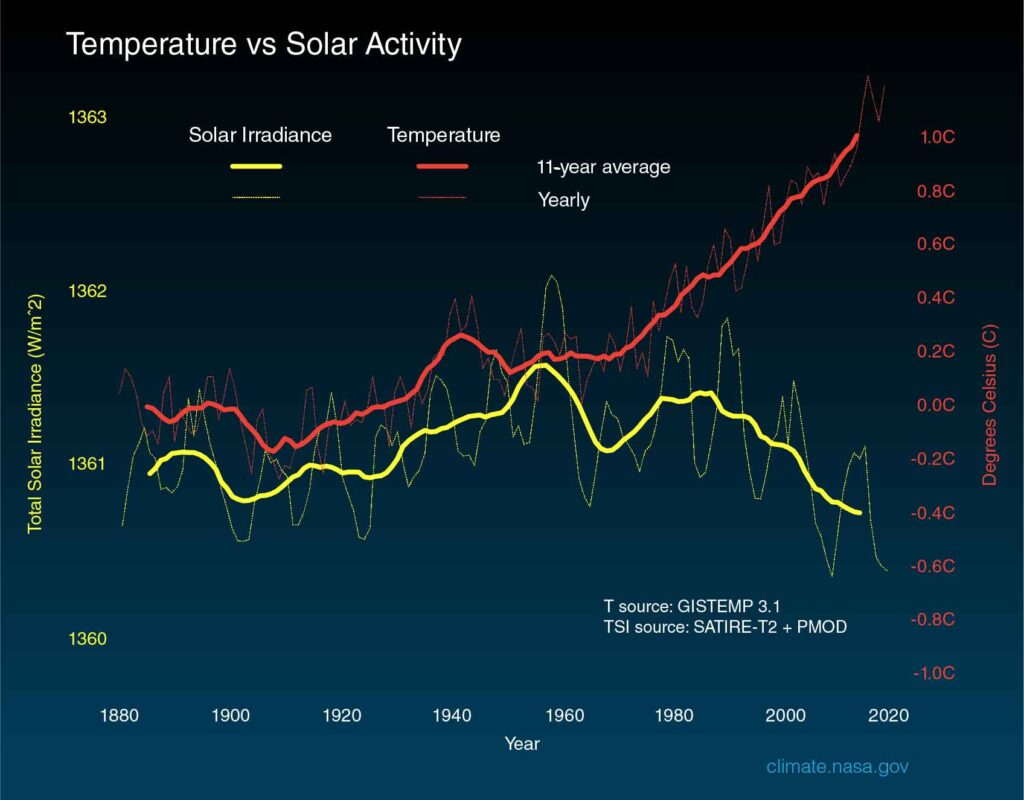
There is greater than a 95% probability that the current state of climate change is due to human activity. Anthropogenic climate change is defined as the rapid warming of the planet Earth due to manmade greenhouse gas emissions. Humans have been having an impact on climate since the dawn of agriculture; the cutting and burning of trees in Europe released carbon dioxide into the atmosphere, and rice paddies emit large amounts of methane.
However, the large change we are seeing in our climate today started following the First Industrial Revolution. When humans started burning fossil fuels as a way to produce energy, they began to release large amounts of greenhouse gasses into the atmosphere. Greenhouse gasses allow incoming shortwave radiation from the Sun to enter our atmosphere. This shortwave radiation is transformed into longwave radiation once it reaches Earth’s surface, and greenhouse gasses trap outgoing longwave radiation by absorbing and reemitting it, which warms our planet.
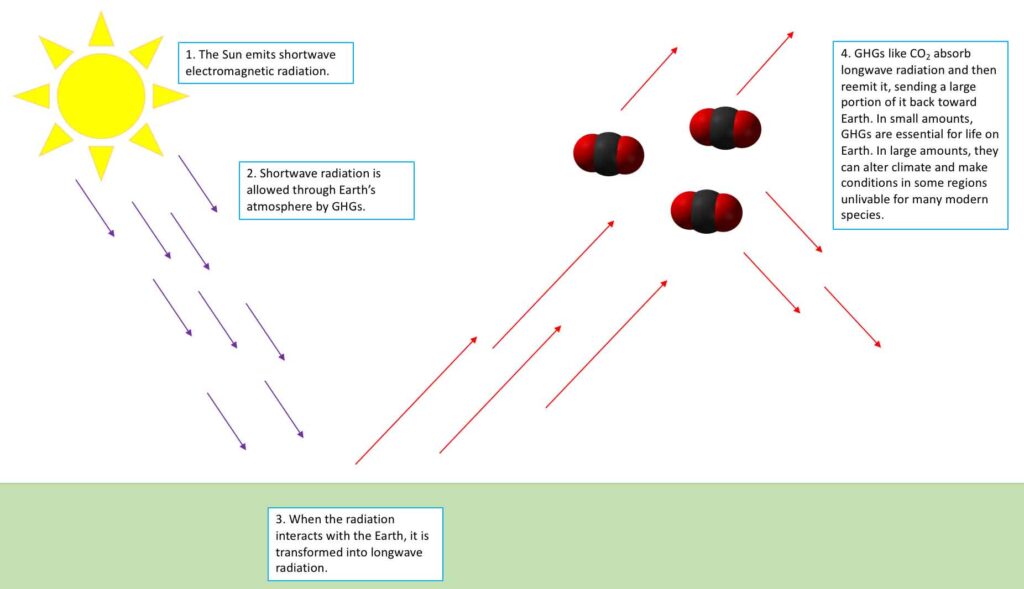
There are several common greenhouse gases that human activity emits. The most well-known is carbon dioxide (CO2). Carbon dioxide naturally makes up a very small component of our atmosphere, ranging from about 180 to 300 parts per million (or about 0.0180-0.0300%). However, human activity has increased atmospheric CO2 by about a third since the beginning of the Industrial Revolution. Before the industrial revolution, CO2 had a concentration of about 280 ppm in the atmosphere, but today that value is around 414.5 ppm. These activities include deforestation, manufacturing, and transportation.
Another greenhouse gas is methane (CH4). While methane is less abundant in the atmosphere than CO2, it is about 25 times more powerful as a greenhouse gas. Methane is commonly produced through agriculture, the decomposition of waste in landfills, and through the digestion and manure of ruminant livestock, namely sheep and cows.
Water vapor also acts as an important greenhouse gas. It is the most abundant of the greenhouse gasses, and as the planet warms, more vapor evaporates, leading to more planet-warming vapor entering the atmosphere. This is known as a positive feedback loop: as the Earth warms, more water evaporates, causing the atmosphere to warm even more.
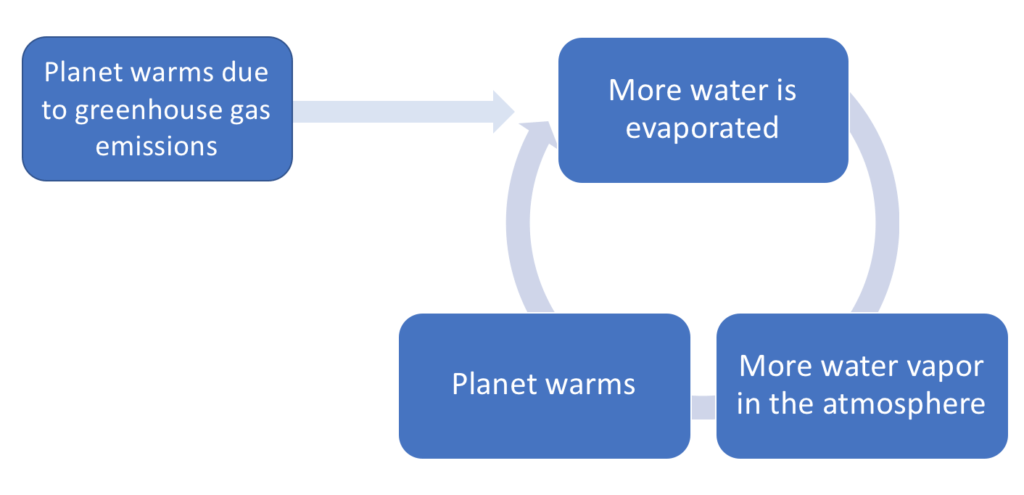
Since the late 19th century, the planet’s average temperature has increased by 0.9 degrees Celsius, or 1.62 degrees Fahrenheit. Most of this warming has been seen in the past few decades, with the six of warmest years on record being every year since 2014. The Intergovernmental Panel on Climate Change (IPCC) predicts a temperature increase of 2.5 to 10 degrees Fahrenheit over the next century. This is bad news; scientists warn that to stave off the worst of climate change, we must keep total warming to under 1.5-2 degrees Celsius, or 2.7-3.6 degrees Fahrenheit.
Climate change is already having an effect on our planet, and its impacts will only grow as temperatures continue to rise. Both the atmosphere and the surface of the Earth have shown consistent warming trends over the past century. Earth’s average surface temperature in 2019 was the second warmest year on record since 1880, with a mean temperature 0.89 degrees Celsius (1.9 degrees Fahrenheit) about the 1951-1980 mean. Global sea surface temperatures have risen as well; from 1901 to 2015, the average sea surface temperature has increased by 0.13 degrees Fahrenheit per decade, with the largest increases in temperature occurring between 1910-1940 and 1970 until the present day.
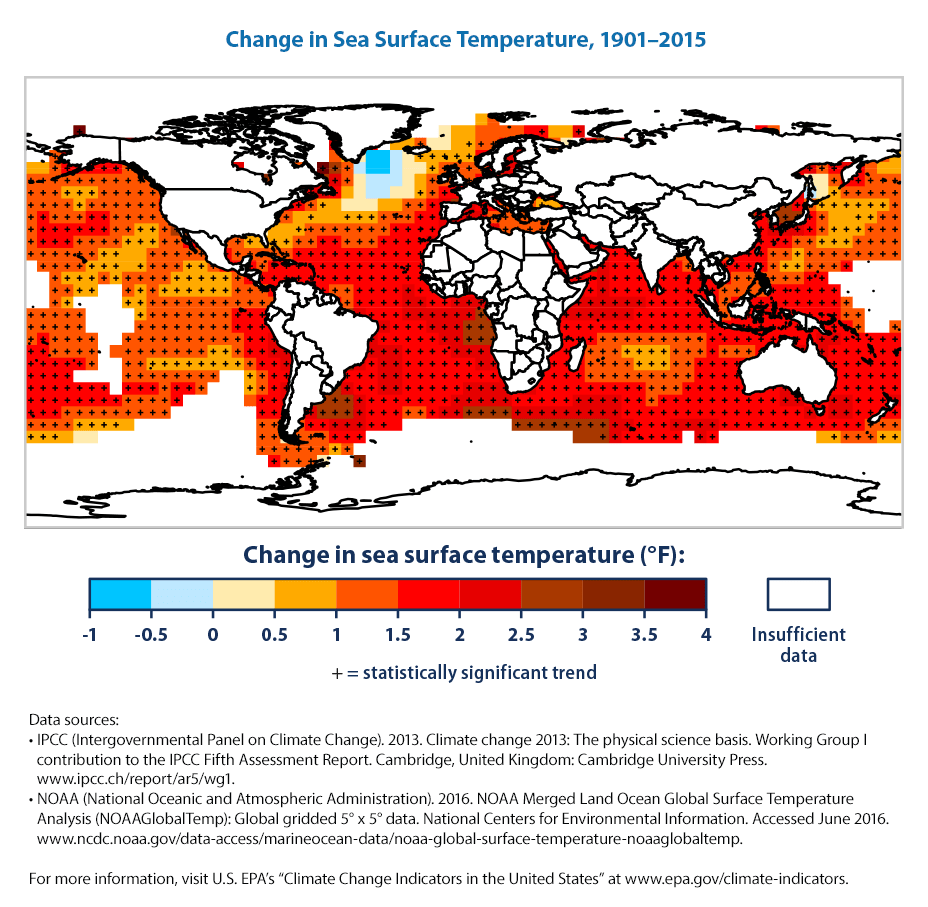
As the climate continues to change, weather patterns will also be altered. In general, wet areas of the planet will get wetter, and dry areas will get drier.
Extreme weather events will also become more intense. As summer temperatures rise, droughts and heat waves will become more common in arid regions like the American Southwest. By the end of the 21st century, heat waves and extreme high temperatures that were once predicted to only occur every 20 years will become commonplace, occurring every two to three years.
In the northern Atlantic region, hurricanes have already been occurring more frequently, more intensely, and for longer periods of time since the 1980s, and these patterns will only continue as climate change becomes worse. The 2020 hurricane season is predicted to be an above-normal season, due at least in part to warmer than average sea surface temperatures driving these storms.
Warming atmospheric and surface temperatures have caused Earth’s ice to begin to melt. Ice on this planet comes in several forms, including glaciers, icebergs, ice sheets, and sea ice.
Glaciers are large bodies of ice that formed from compacted ice and snow. They are constantly moving due to gravity and their own weight. Icebergs are parts of glaciers or ice sheets that break off and float in the ocean. Due to the density of ice, only about 10% of any iceberg floats on top of the water.
Ice sheets are permanent, large layers of ice that cover large areas of land. Earth has two ice sheets: the Antarctic ice sheet and the Greenland ice sheet. Together, these two ice sheets make up 99.6% of the global ice volume.
When icebergs break off from land ice or when glaciers and ice sheets melt, the additions to the ocean’s volume contribute to sea level rise. The sea level has already risen by 8 inches since 1880, and it is predicted to rise another 1-8 feet by 2100, depending on rates of warming and the rates of ice melts. Thermal expansion, which is the increase in volume of water when it is heated, is also contributing to our increased sea levels.
Ice sheets have ice shelves, which are parts of the ice sheet that extend to the sea. Because ice shelves are already floating on the water, they do not contribute to sea level rise when they break off. However, their calving off can have a devastating effect, as these shelves act like dams, holding melting ice from the land back. When an ice shelf collapses, the melting of an ice sheet and its addition to sea level rise accelerates.
Sea ice is ice that forms from the freezing of seawater, which occurs below -1.8℃. As it exists entirely in the ocean, its melting does not contribute to sea level rise. However, it is an important part of the habitat for many species in the Arctic, such as seals and polar bears, so its melting harms many animals.
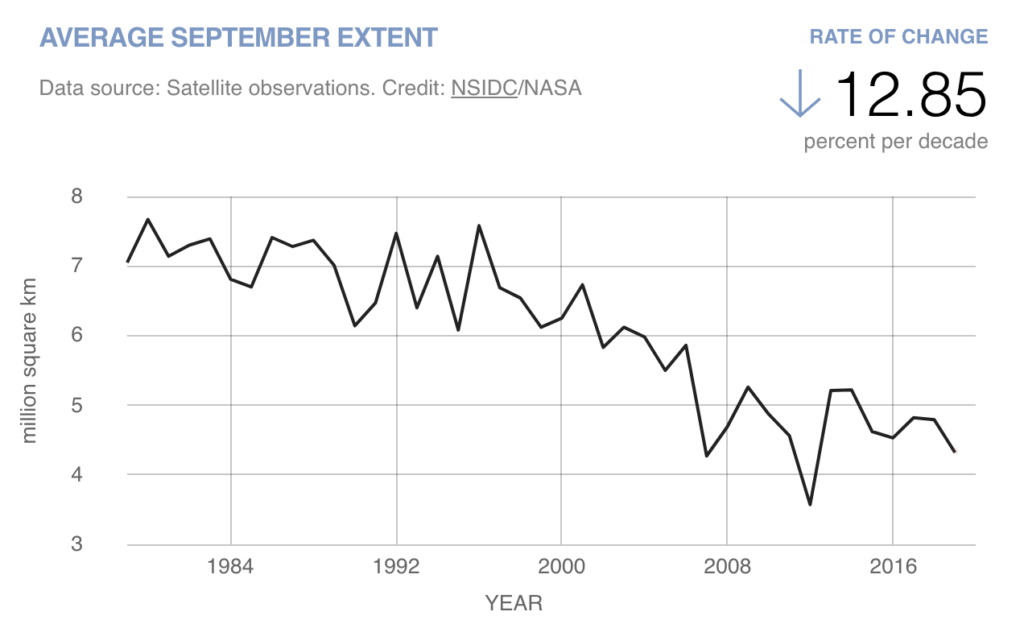
Melting ice causes another positive feedback loop that is contributing toward climate change: the albedo effect. In essence, albedo is the amount of light reflected by a surface. Surfaces with high albedo, like ice, reflect large amounts of sunlight, and surfaces with low albedo, such as dark ocean waters, absorb sunlight. As ice melts due to climate change warming the planet, there are less reflective surfaces on the planet and more absorptive surfaces. This speeds up the rate of climate change.
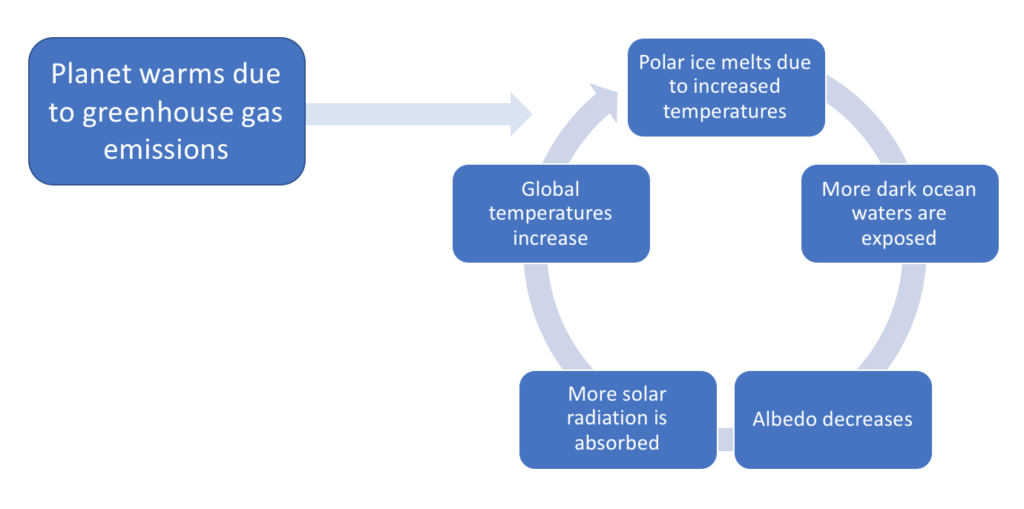
Oceans actually take up about 90% of the energy from greenhouse gases, and they store that heat for around 1500 years. 48% of anthropogenic CO2 emitted since 1800 has been absorbed by the ocean, and our ocean currently contains around 39,000 gigatons of carbon.
That being said, we should not and cannot rely on this cooling effect from the oceans to solve our climate problem. The excess carbon being taken up by the ocean leads to another effect of climate change: ocean acidification. Since the industrial revolution, the ocean’s pH has dropped from 8.2 to 8.1. By the end of the century, the pH may drop by another 0.3-0.4 points. While this may not seem like a large change, the pH scale is a logarithmic scale, so this 0.3-0.4 point change in pH is about a 120% difference, and it would be the most acidic the ocean has been in about 20 million years.
When carbon dioxide enters the ocean, it reacts with water to form carbonic acid. This further reacts and breaks down into bicarbonate and free hydrogen ions, which reduces the pH of the water, making it more acidic. The free hydrogen ions bond with other materials, such as carbonates that many marine animals like mollusks, corals, and zooplankton need to survive and build their shells. The process can even dissolve the shells and structures of these creatures. Even organisms that do not have exposed carbonate structures, such as plant life and fishes, may be affected due to the changes in their environment.

And while the effects on nature may seem bad enough, those effects of climate change are only the beginning. The health and wellbeing of all people are at stake because of climate change and the burning of fossil fuels.
Burning fossil fuels causes harmful substances to enter the atmosphere, such as particulate matter, carbon monoxide, nitrogen dioxide, sulphur dioxide, and ozone. In small amounts, these compounds are not harmful, but in the large amounts released by burning fossil fuels for transportation and industry, it is detrimental to human health. In 1993, a revolutionary study known as the Six Cities study was published. The authors looked at air quality across six cities in the United States and found that as the volume of fine particulate matter in the air increased, so did mortality. Air pollution from fossil fuels has been linked to stroke, respiratory illness, lung cancer, pneumonia, high blood pressure, congestive heart failure, insulin resistance, and premature birth. The risks linked to air pollution are also unevenly distributed throughout our communities, with the poor, people of color, those in urban areas, and the elderly being at a higher risk.
Climate change will also have a direct effect on human health. Due to predicted heavier rains in New Jersey, there will be increased risks of flooding, which can be especially dangerous for those who need transportation to medical centers. Increased rains may also lead to more water contamination as runoff carries more pollutants and bacteria into our water supplies. There may be an increased presence of allergens like pollen due to longer warm seasons, which may lead to increased cases and intensity of asthma. The changes in climate patterns will affect growing seasons and our ability to raise crops worldwide, most likely resulting in a reduction in food production and a strain to provide enough calories for the global population. The high amounts of heat and moisture will also provide an optimal environment for mosquitoes and other pests, leading to more vector-borne diseases, including diseases carried by invasive mosquitoes that can creep into more northern territory as temperatures increase. Increased temperatures will also lead to more cases of heat stroke and dehydration. Physical health is not all that will be impacted; it is likely that mental health will also depreciate due to climate change related stress and due to concerns about more intense and often extreme weather events.
Without a rapid, effective response to reduce the emission and presence of greenhouse gases in our atmosphere, climate change could have a catastrophic effect on our environment and on humanity. The Earth is warming, and it is our fault. That being said, there is hope. We still have the time, the resources, and the ability to reduce the negative impacts of climate change and do better.
Many scientists use 1.5-2℃ of warming above pre-industrial levels as a goal for mankind to reduce the impacts of climate change as much as possible. However, as the planet has already warmed by about 0.9℃ and our damaging practices regarding fossil fuels and agriculture have not slowed, there is only about a 5% probability that we will stay under 2℃ warming by the end of the century; it is projected that the Earth will hit anywhere from 2-5℃ above pre-industrial temperatures by 2100, depending on how we respond to climate change now.
There are four main ways we can respond to climate change: do nothing, mitigation, adaptation, and geoengineering. Doing nothing and continuing our reliance on fossil fuels is not an option if we want the planet to remain survivable to human beings and a majority of species on this planet. So, let’s take a look at our other three options.
Mitigation is the act of reducing the severity of the consequences. In terms of climate action, this largely means slowing and eventually stopping the burning of fossil fuels. This also includes other actions to reduce our greenhouse gas emissions, such as producing food more sustainably and more wisely using our land. This is by far the cheapest option of the three solutions to reduce the impact of climate change. The main step we could take to mitigate the effects of greenhouse gas emissions are deviating away from fossil fuel use and ramping up the use of renewable energy sources, such as solar and wind.
Adaptation refers to two choices: we can adapt to climate change by engineering protection against the worst effects of our altered climate, or we can adapt by relocating. Examples of engineering that can be used to help adapt to the effects of climate change are structures that can help prevent flooding, buildings that can withstand hurricanes, and water delivery and purification systems that can help support human populations during drought. Some regions of the world will simply become inhospitable due to the rise in temperatures, so people living in those areas will have to relocate to survive. However, not everyone will be able to adapt to climate change, and the regions of the world that are less responsible for emissions—such as the tropics, small islands, and the global south— are not well equipped to handle the stresses of increased temperatures, changes in precipitation, and sea level rise.
The potentially most complicated and expensive option, but also perhaps the option with the best potential to reduce the negative impacts of climate change, is geoengineering. By mechanically manipulating the climate system, we can reduce climate change in two ways: by reducing the amount of incoming shortwave radiation, and by removing carbon dioxide and other greenhouse gases from the atmosphere. These solutions can be as simple as creating green spaces in deserts so plants can absorb more carbon, to as complicated as figuring out how to capture and store atmospheric carbon in rocks. Some of these options, such as increasing the reflectivity of urban surfaces so materials like asphalt absorb less heat, are relatively low cost and low risk, but may not be very effective. Other solutions, such as placing large reflectors in space, may be very effective, but the cost will be great. Still other solutions, such as releasing aerosols into the atmosphere, are low cost and are likely to be very effective, but have a high risk of unintended consequences.

Climate change is too large of an issue for any one person to tackle it alone. To effectively combat the worst effects, we must all work together and do our part. While small individual actions— reducing meat consumption, driving less, and more effectively using energy— can help, for real positive change we need global action. By educating your family and friends about how climate change affects everyone and the possible solutions we have, you can create a more informed public that is more aware of the science of climate and the importance of action. And by advocating and voting for policies and politicians that are committed to finding climate solutions, you can help create a greener future for generations to come.



